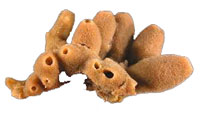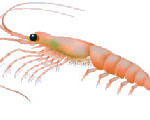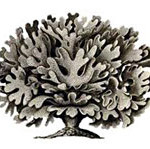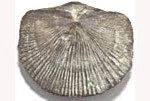
Porifera
With more than 5000 species known across the world, sponges, (Porifera) come in an incredible variety of colors and an amazing array of shapes, ranging from a few millimetres to two metres across. They are predominantly marine and are found in virtually all aquatic habitats, although approximately 150 species are found in freshwater. The phylum name Porifera means porebearing, reflecting the perforated surfaces of the sponge’s tissue.
Sponge shape and size is affected to some degree by the environmental conditions they inhabit – strong currents, differing substrata and so forth lead to a great diversity even amongst the same species. Sponges are primitive multi cellular animals whose porous body is supported by a fibrous skeletal framework. They have a simple kind of cellular-level organization, meaning that that their cells are specialized so that different cells perform different functions. However, similar cells are not organized into tissues and the body is a sort of loose aggregation of different kinds of cells.
Despite being classified as this most primitive form of simplistic body structure that lacks organs and true tissues, sponges can demonstrate sophisticated cellular systems, complex developmental and reproductive processes, versatility in feeding behaviour, production of unique natural chemicals and intimate symbiotic relationships with other organisms
Dependent on how the body is organised, sponges fall into three main groups. The simplest form is the asconoid group of sponges. These are shaped like a simple tube perforated by pores. The open internal part of the tube is called the spongocoel; it contains the collar cells which carry beating flagellae, the tiny hairs which drive water movement. The single opening to the outside is called the osculum.
The syconoid group of sponges are the next most complicated group. These tend to be larger than asconoids and also have a tubular body with a single osculum, but their body wall is thicker and the pores that penetrate it are longer, forming a system of simple canals. These canals are lined by collar cells, the flagellae of which move water from the outside, into the spongocoel and out the osculum.
The largest and most complex sponges are the leuconoids. These sponges are made up of masses of tissue penetrated by numerous canals which lead to numerous small chambers lined with collar cells. Water moves through the canals, into these chambers, and out via a central canal and osculum.
Sponges feed on detritus particles, plankton and bacteria that are brought close by water currents created by the collar cells. Food items are taken into individual cells where digestion occurs.
As with Bryozoa in the section above, sponges can reproduce by both sexual and asexual means. Asexual reproduction is via external budding, although some species can also form internal buds, or gemmules, which can survive conditions that would otherwise kill the parent sponge.
Sponges also provide a home for a number of small marine plants, which live in and around their pore systems. Symbiotic relationships with bacteria and algae have also been reported, in which the sponge provides its symbiotic partner with support and protection in return for a range of benefits including nutrition, transportation of chemicals throughout the sponge tissue, assistance in chemical defence and removal of waste products from the sponge. The microbial biomass can also contribute to the rigidity of the sponge structure.
The world of medical science has a keen interest in sponges, as they are the source of more natural chemicals than any other marine invertebrate. Many of these compounds have potent bioactive properties (anti-tumour, anti-inflammatory, anti-viral and anti-microbial.
The microbial community associated with Antarctic sponges is well adapted to extreme and pristine, environmental conditions. This makes them potentially susceptible to small-scale fluctuations in water quality and levels of environmental contamination. Antarctic sponges have been found to be long-lived and sensitive to disturbance. As such, they represent sensitive indicator species reflecting environmental health.







Social Profiles